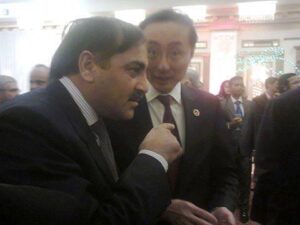By Qamar Bashir
I was a member of the inquiry and investigation team commissioned by the Ministry of Information, Broadcasting, and Heritage to investigate the
disappearance of high-value paintings and artefacts allegedly sold on the black market with the connivance of Pakistan National Council of Arts (PNCA) officers and staff. We used a scientific method. We took the inventory in our possession, converted one of the exhibition halls into an inspection area, and inspected the entire collection of art and artefacts one-by-one. After comparing the results to the original inventory, we discovered that a number of priceless works by renowned and legendary artists were missing, including some high-value calligraphy by
Sadequain.
The results of the investigation were duly referred to the FIA for further
investigation, identification of the perpetrator, and recovery of the missing pieces.
To my surprise, some of the missing Sadequain's paintings were on exhibit in the
ambassador's room and the foyer when I was later assigned as the Press Minister to
the Pakistani Embassy in France. I reported the discovery of the lost paintings to
the ministry, but was unable to pursue the outcome of my report.
Once, in my office in Paris, we were discussing Sadequain's paintings when a
friend of a friend proudly announced that he has over seventy-five pieces of
Sadequain's calligraphic work that have not yet been exhibited anywhere in the
world and are safely stored in his native home in Kharian, close to Jhelum.
I did not pay much attention to his boasting, but the next day he brought a nicely
printed catalogue of the painting with pictures and their illustration and offered to
exhibit these priceless and previously undiscovered artefacts in Paris to
demonstrate Pakistan's mastery of the art of calligraphy.
I introduced him to the Ambassador, and we decided to enlist a French museum or
art gallery as a partner in order to exhibit these priceless and uncommon works of
art. He recounted the history of his cherished possession during this conversation.
He stated that he had eight siblings, all of whom were handicapped, and that he
was the only one with normal abilities. He stated that his heart used to bleed as he
watched his mother struggle alone with no PDA school within miles, until her
death, which left him in charge of his precious siblings. As a tribute to my late
mother I resolved to build a state-of-the-art facility in the heart of rural Punjab to
alleviate all mothers with Persons with Different Abilities (PDAs) of this immense
and overwhelming responsibility. This was my motivation throughout my entire
youth and adulthood in France: to amass sufficient wealth to start and finish the
undertaking of my dreams. Due to my dexterity and diligence, a renowned French
architect and building contractor employed me as a caretaker, but due to my
integrity and diligence, he adopted me as a family member. Incidentally, he was a
friend of Sadequain and had always been his host during his time in Paris during
the 1960s and 1970s. For Sadaquain, this was the most productive period of his
artistic career, and he tirelessly produced high-quality works of art and being a
carefree person he donated 75 pieces to art work his French host, and before the
french host passed away, he gave them to me and since then I have kept them in
my possession under lock and key. Until I realised that now is the time to share
them with art enthusiasts and sadaquine's admirers around the globe. The Pakistan
Embassy of France should take this pride in displaying them in a suitable venue in
France to showcase Pakistan’s prowess in high end art and paintings.
Spellbound by his story, the Ambassador’s next question was about his dream of
setting up of a facility for handicapped persons and once again we were awed by
his amazing story as to how he converted his dream into reality. He said with his
lifelong saving in Paris he return to Pakistan in 1990 and setup a school with a
few handicapped children in Kharain his native town. Meanwhile, the groundwork
was set for the development of cutting-edge facilities, which was inaugurated in
2009. Claude Monet, a well-known French painter and architect, designed the
facility. The project was funded by me and my close acquaintances who shared a
similar passion. The facility was registered as Al-Mudassar Trust, and it is now
housed in a state-of-the-art complex with five separate schools for blinds and
deafs, physically and mentally challenged, a vocational center, rehabilitation lab
each manned by a separate team of dedicated, motivated, and well-paid
professional teachers and trainers. The schools have fully equipped classrooms,
computer labs, audio testing facilities, Lego laboratories and libraries, a resource
centre, a mosque, playgrounds, and boys and girls hostels where over 500 students
of varying abilities are housed, fed, and provided with one of the best customised
educations and extracurricular activities. Currently, construction of a state of the
art special college facility is nearing completion, with plans to expand it to the
university level in the near future.
We heard his story in total disbelief, but somehow since then we were connected
via whatsapp. Later, I was transferred to Pakistan in 2020 and it was not until




